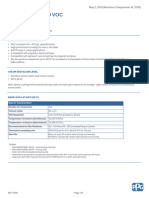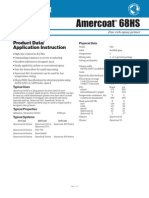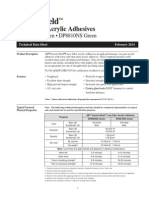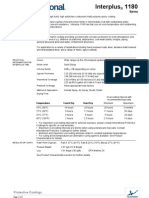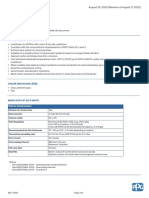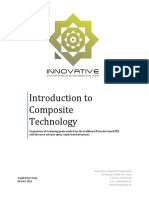Amercoat® 385: Product Data Sheet
Amercoat® 385: Product Data Sheet
Uploaded by
Sampath GaneshCopyright:
Available Formats
Amercoat® 385: Product Data Sheet
Amercoat® 385: Product Data Sheet
Uploaded by
Sampath GaneshOriginal Title
Copyright
Available Formats
Share this document
Did you find this document useful?
Is this content inappropriate?
Copyright:
Available Formats
Amercoat® 385: Product Data Sheet
Amercoat® 385: Product Data Sheet
Uploaded by
Sampath GaneshCopyright:
Available Formats
PRODUCT DATA SHEET June 2, 2017 (Revision of April 25, 2017)
AMERCOAT® 385
DESCRIPTION
Two-component, high-build, multipurpose polyamide cured epoxy coating
PRINCIPAL CHARACTERISTICS
• Multi-purpose high build epoxy
• High solids high build epoxy intermediate coat
• Compatibility with a wide range of substrates and surface preparations
• Excellent resistance against chemical spillage
• AMERCOAT 385 PA contains zinc phosphate for enhanced corrosion inhibitive performance, which is available in US and
Asia Pacific only
• Also available with MIO pigmentation
• AMERCOAT 385 LH is formulated for a lower level of HAPs, which is available only in US
COLOR AND GLOSS LEVEL
• White, Black, Oxide Red, Light Buff, Pearl Gray
• Flat
Notes:
- Epoxy coatings will chalk and fade upon exposure to sunlight, elevated temperatures, or chemical exposure. Discoloration and normal
chalking does not impact performance. Light colors will darken over time. Some batch-to-batch variation in color is to be expected. Color
matches are approximate.
- AMERCOAT 385 PA Red (MIO containing formula), AMERCOAT 385 PA Buff (no MIO)
BASIC DATA AT 68°F (20°C)
Data for mixed product
Number of components Two
Mass density 1.4 kg/l (11.7 lb/US gal)
Volume solids 68 ± 2%
VOC (Supplied) max. 2.6 lb/US gal (approx. 312 g/l)
Temperature resistance (Continuous) To 200°F (93°C)
Temperature resistance (Intermittent) To 250°F (121°C)
Recommended dry film thickness 3.0 - 8.0 mils (75 - 200 µm) depending on system
Theoretical spreading rate 218 ft²/US gal for 5.0 mils (5.4 m²/l for 125 µm)
Ref. P065 Page 1/8
PRODUCT DATA SHEET June 2, 2017 (Revision of April 25, 2017)
AMERCOAT® 385
Data for mixed product
Shelf life Base: at least 36 months when stored cool and dry
Hardener: at least 24 months when stored cool and dry
Notes:
- See ADDITIONAL DATA – Overcoating intervals
- See ADDITIONAL DATA – Curing time
- Color will drift at elevated temperatures
- Intermittent temperature resistance should be less than 5% of the time, and maximum 24 hours
- For immersion service, the product should be applied at a minimum of 10 mils (250 µm) dft total in 2 – 3 coats
- Do not recommend to use zinc phosphate version for immersion, Contact PPG Technical Service for immersion
RECOMMENDED SUBSTRATE CONDITIONS AND TEMPERATURES
• Coating performance is, in general, proportional to the degree of surface preparation
• Abrasive blasting is usually the most effective and economical method. When this is impossible or impractical, coating can
be applied over mechanically cleaned surfaces
• All surfaces must be clean, dry and free of all contaminants, including salt deposits. Contact PPG for maximum allowable
salt containment levels
Mild steel
• Remove all loose rust, dirt, grease or other contaminants by one of the following depending on the degree of cleanliness
required: SSPC SP-2, 3, 6, 7 or 10 (ISO 8501-1 St-2, St-3, Sa 1, Sa 2, Sa 2.5). These minimum surface preparation
standards apply to steel that has been previously abrasive blasted. The choice of surface preparation will depend on the
system selected and end-use service conditions
• For immersion and severe duty applications, the recommended blast profile is 2.0 – 4.0 mils (50 – 100 µm). Previously
blasted steel may be ultra-high pressure water jetted to SSPC -SPWJ-2(L) / NACE WJ-2(L). The wet surface can be dried by
blowing with dry compressed air giving special attention to horizontal surfaces and recesses
Concrete
• Remove grease, oil and other penetrating contaminants according to ASTM D4258
• Abrade surface per ASTM D-4259 to remove all efflorescence and laitance, to expose subsurface voids, and to provide a
surface roughness equivalent of 60 grit sandpaper or coarser
• AMERCOAT 114 A may be used as a pit filler. Check with PPG Technical Service for alternative
• Maximum recommended moisture transmission rate is 3 lbs / 1,000 ft2 / 24 hours by moisture transmission test (ASTM
F1869, calcium chloride test or by ASTM D4263, plastic sheet test)
• Alternatively, ASTM D4944 (Calcium Carbide Gas method) can be used, moisture content should not exceed 4%
Ref. P065 Page 2/8
PRODUCT DATA SHEET June 2, 2017 (Revision of April 25, 2017)
AMERCOAT® 385
Galvanized steel
• Remove oil or soap film with detergent or emulsion cleaner
• Lightly abrasive blast with a fine abrasive in accordance with SSPC SP-16 guidelines to achieve a profile of 1.5 – 3.0 mils
(38 – 75 µm). When light abrasive blasting is not possible, galvanizing can be treated with a suitable zinc phosphate
conversion coating.
• Galvanizing that has at least 12 months of exterior weathering and has a rough surface with white rust present may be over-
coated after power washing and cleaning to remove white rust and other contaminants
• The surface must have a measurable profile
• A test patch is recommended to determine compatibility and adhesion
• Not recommended over chromate sealed galvanizing without blasting to thoroughly remove chromates. Adhesion problems
may occur
Non-ferrous metals and stainless steel
• Abrasive blast in accordance with SSPC SP-16 guidelines to achieve a uniform and dense 1.5-4.0 mils (38 – 100 µm) anchor
profile. Size and hardness of abrasive should be adjusted as necessary based on the hardness of the substrate
• Aluminum may be treated with a surface treatment compliant with Mil-DTL-5541 or equivalent (non-immersion applications
only).
Aged coatings
• All surfaces must be clean, dry, tightly bonded and free of all loose paint, corrosion products or chalky residue
• Abrade surface, or clean with PREP 88. This product is compatible over most types of properly applied and tightly adhering
coatings, however, a test patch is recommended to confirm compatibility
Repair
• Prepare damaged areas to original surface preparation specifications, feathering edges of intact coating. Thoroughly
remove dust or abrasive residue before touch-up.
Substrate temperature and application conditions
• Surface temperature during application should be at least 5°F (3°C) above dew point
• Ambient temperature during application and curing should be between 40°F (4°C) and 122°F (50°C)
• Relative humidity during application should not exceed 85%
SYSTEM SPECIFICATION
• Primers: Direct to substrate; DIMETCOTE- Series Primers, AMERCOAT 68HS, AMERCOAT 68MCZ
• Topcoats: AMERCOAT 450-Series Polyurethanes, AMERSHIELD, PSX 700, AMERCOAT 229T, PITTHANE Polyurethanes
INSTRUCTIONS FOR USE
Mixing ratio by volume: base to hardener 50:50 (1:1)
• Pre-mix base component with a pneumatic air mixer at moderate speeds to homogenize the container. Add hardener to
base and agitate with a power mixer for 1–2 minutes until completely dispersed
Ref. P065 Page 3/8
PRODUCT DATA SHEET June 2, 2017 (Revision of April 25, 2017)
AMERCOAT® 385
Induction time
Mixed product induction time
Mixed product Induction time
temperature
Below 60°F (16°C) 30 minutes
60°F (16°C) 15 minutes
Above 75°F (24°C) None
Pot life
3 hours at 70°F (21°C)
Note: See ADDITIONAL DATA – Pot life
Application
• Area should be sheltered from airborne particulates and pollutants
• Avoid combustion gases or other sources of carbon dioxide that may promote amine blush and ambering of light colors
• Ensure good ventilation during application and curing
• Provide shelter to prevent wind from affecting spray patterns
Material temperature
Material temperature during application should be between 50°F (10°C) and 90°F (32°C)
Air spray
• Use standard conventional equipment
Recommended thinner
THINNER 91-92 for global, THINNER 21-06 (AMERCOAT 65) or THINNER 21-25 (AMERCOAT 101) for above 90°F (32°C) in US
and Canada
Volume of thinner
0 - 20%
Nozzle orifice
Approx. 0.070 in (1.8 mm)
Ref. P065 Page 4/8
PRODUCT DATA SHEET June 2, 2017 (Revision of April 25, 2017)
AMERCOAT® 385
Airless spray
• 45:1 pump or larger
• Can be applied with plural component equipment
• Hoses should normally be kept as short as possible
Recommended thinner
THINNER 91-92 for global, THINNER 21-06 (AMERCOAT 65) or THINNER 21-25 (AMERCOAT 101) for above 90°F (32°C) in US
and Canada
Nozzle orifice
0.017 – 0.019 in (approx. 0.43 – 0.48 mm)
Brush/roller
• Use a high quality natural bristle brush and/or solvent resistant, 3/8" nap roller. Ensure brush/roller is well loaded to avoid air
entrainment. Multiple coats may be necessary to achieve adequate film-build
Recommended thinner
THINNER 91-92 for global, THINNER 21-06 (AMERCOAT 65) or THINNER 21-25 (AMERCOAT 101) for above 90°F (32°C) in US
and Canada
Cleaning solvent
THNNER 90-53, THINNER 90-58 (AMERCOAT 12) OR THINNER 21-06 (AMERCOAT 65)
ADDITIONAL DATA
Overcoating interval for DFT up to 8.0 mils (200 µm)
Overcoating with... Overcoating Interval 40°F (4°C) 50°F (10°C) 60°F (16°C) 70°F (21°C) 90°F (32°C)
itself Minimum 3 days 42 hours 24 hours 12 hours 6 hours
Maximum Unlimited Unlimited Unlimited Unlimited Unlimited
Maximum - immersion 30 days 30 days 30 days 30 days 30 days
Ref. P065 Page 5/8
PRODUCT DATA SHEET June 2, 2017 (Revision of April 25, 2017)
AMERCOAT® 385
Overcoating interval for DFT up to 8.0 mils (200 µm)
Overcoating with... Interval 40°F (4°C) 50°F (10°C) 60°F (16°C) 70°F (21°C) 90°F (32°C)
urethane and PSX Minimum 3 days 42 hours 24 hours 12 hours 6 hours
Maximum 3 months 2.5 months 2 months 1.5 months 1.5 months
Notes:
- Dry times are dependent on air and surface temperatures as well as film thickness, ventilation, and relative humidity. Maximum recoating
time is highly dependent upon actual surface temperatures – not simply air temperatures. Surface temperatures should be monitored,
especially with sun-exposed or otherwise heated surfaces. Higher surface temperatures shorten the maximum recoat window
- Surface must be clean and dry. Any contamination must be identified and removed. A detergent wash with PREP 88 or equivalent is
required prior to application of topcoats after 30 days of exposure. However, particular attention must be paid to surfaces exposed to
sunlight where chalking may be present. In those situations, a further degree of cleaning may be required. PPG Technical Service can
advise on suitable cleaning methods. If maximum recoat/topcoat time is exceeded, then roughen surface.
Curing time for DFT up to 8.0 mils (200 µm)
Substrate temperature Dry to touch Dry to handle Full cure
40°F (4°C) 8 hours 4 days 21 days
50°F (10°C) 4 hours 24 hours 14 days
60°F (16°C) 3 hours 20 hours 7 days
70°F (21°C) 2 hours 16 hours 6 days
90°F (32°C) 1 hour 10 hours 4 days
Notes:
- Adequate ventilation must be maintained during application and curing (please refer to INFORMATION SHEETS 1433 and 1434)
- Please contact your PPG representative for further details
Pot life (at application viscosity)
Mixed product temperature Pot life
50°F (10°C) 5 hours
70°F (21°C) 3 hours
90°F (32°C) 1.5 hours
Product Qualifications
• Mil-PRF-23236(C) Type V, Class 7, Grade C
• Military Sealift Command – Underwater hulls, topside and salt water ballast tank service
• Compliant with USDA Incidental Food Contact Requirements
• NFPA Class A for Flame Spread and Smoke Development
• NORSOK M501 Rev. 5, System 7 Subsea surfaces
• MPI Category #108
Ref. P065 Page 6/8
PRODUCT DATA SHEET June 2, 2017 (Revision of April 25, 2017)
AMERCOAT® 385
SAFETY PRECAUTIONS
• For paint and recommended thinners see INFORMATION SHEETS 1430, 1431 and relevant Material Safety Data Sheets
• This is a solvent-borne paint and care should be taken to avoid inhalation of spray mist or vapor, as well as contact between
the wet paint and exposed skin or eyes
WORLDWIDE AVAILABILITY
It is always the aim of PPG Protective and Marine Coatings to supply the same product on a worldwide basis. However, slight
modification of the product is sometimes necessary to comply with local or national rules/circumstances. Under these
circumstances an alternative product data sheet is used.
REFERENCES
• CONVERSION TABLES INFORMATION SHEET 1410
• EXPLANATION TO PRODUCT DATA SHEETS INFORMATION SHEET 1411
• SAFETY INDICATIONS INFORMATION SHEET 1430
• SAFETY IN CONFINED SPACES AND HEALTH SAFETY, EXPLOSION HAZARD – INFORMATION SHEET 1431
TOXIC HAZARD
WARRANTY
PPG warrants (i) its title to the product, (ii) that the quality of the product conforms to PPG’s specifications for such product in effect at the time of manufacture and (iii) that the product shall be delivered free of the rightful claim of any
third person for infringement of any U.S. patent covering the product. THESE ARE THE ONLY WARRANTIES THAT PPG MAKES AND ALL OTHER EXPRESS OR IMPLIED WARRANTIES, UNDER STATUTE OR ARISING OTHERWISE IN
LAW, FROM A COURSE OF DEALING OR USAGE OF TRADE, INCLUDING WITHOUT LIMITATION, ANY OTHER WARRANTY OF FITNESS FOR A PARTICULAR PURPOSE OR USE, ARE DISCLAIMED BY PPG. Any claim under this
warranty must be made by Buyer to PPG in writing within five (5) days of Buyer’s discovery of the claimed defect, but in no event later than the expiration of the applicable shelf life of the product, or one year from the date of the
delivery of the product to the Buyer, whichever is earlier. Buyer’s failure to notify PPG of such non-conformance as required herein shall bar Buyer from recovery under this warranty.
LIMITATIONS OF LIABILITY
IN NO EVENT WILL PPG BE LIABLE UNDER ANY THEORY OF RECOVERY (WHETHER BASED ON NEGLIGENCE OF ANY KIND, STRICT LIABILITY OR TORT) FOR ANY INDIRECT, SPECIAL, INCIDENTAL, OR CONSEQUENTIAL
DAMAGES IN ANY WAY RELATED TO, ARISING FROM, OR RESULTING FROM ANY USE MADE OF THE PRODUCT. The information in this sheet is intended for guidance only and is based upon laboratory tests that PPG believes to
be reliable. PPG may modify the information contained herein at any time as a result of practical experience and continuous product development. All recommendations or suggestions relating to the use of the PPG product, whether in
technical documentation, or in response to a specific inquiry, or otherwise, are based on data, which to the best of PPG’s knowledge, is reliable. The product and related information is designed for users having the requisite knowledge
and industrial skills in the industry and it is the end-user’s responsibility to determine the suitability of the product for its own particular use and it shall be deemed that Buyer has done so, as its sole discretion and risk. PPG has no
control over either the quality or condition of the substrate, or the many factors affecting the use and application of the product. Therefore, PPG does not accept any liability arising from any loss, injury or damage resulting from such
use or the contents of this information (unless there are written agreements stating otherwise). Variations in the application environment, changes in procedures of use, or extrapolation of data may cause unsatisfactory results. This
sheet supersedes all previous versions and it is the Buyer’s responsibility to ensure that this information is current prior to using the product. Current sheets for all PPG Protective & Marine Coatings Products are maintained at
www.ppgpmc.com. The English text of this sheet shall prevail over any translation thereof.
Ref. P065 Page 7/8
PRODUCT DATA SHEET June 2, 2017 (Revision of April 25, 2017)
AMERCOAT® 385
Packaging: Available in 2-gallon and 10-gallon kits; (2-gallon kits have 1 full gallon of base and 1 full gallon of hardener, 10 gallon
kits have 5-gallons of base and 5-gallons of hardener)
Product code Description
AT 385-1 Buff Base
AT 385-3 White Base
AT 385-9 Black Base
AT 385-23 Pearl Gray Base
AT 385-72 Oxide Red Base
AT385A-1 AMERCOAT 385PA Buff
(contains zinc phosphate)
AT385A-7 AMERCOAT 385 PA Red
(contains micaceous iron oxide)
AT385-B Hardener
AT385LH23 LH Pearl Gray Base (US only)
AT385LH702 LH Solar Red Base (US only)
AT385LH-B LH Hardener (US only)
The PPG Logo, Bringing innovation to the surface., and all other trademarks herein are property of the PPG group of companies.
Ref. P065 Page 8/8
You might also like
- Carboguard 60 PDSDocument2 pagesCarboguard 60 PDSsalamrefigh0% (1)
- On:-Types of Cracks in Walls, Ceilings, Plaster and DoorsDocument11 pagesOn:-Types of Cracks in Walls, Ceilings, Plaster and DoorsParthil MajumdarNo ratings yet
- VESFG001Document60 pagesVESFG001romeo112976100% (2)
- Amercoat® 385: Product Data SheetDocument8 pagesAmercoat® 385: Product Data SheetNizar BouchaalaNo ratings yet
- PPG PDS Amercoat 370Document7 pagesPPG PDS Amercoat 370sanguripNo ratings yet
- Amerlock® 400 Voc: Product Data SheetDocument8 pagesAmerlock® 400 Voc: Product Data SheetCris gomezNo ratings yet
- 7) PPG Amercoat 385 - Pds - AiDocument4 pages7) PPG Amercoat 385 - Pds - AididbeauNo ratings yet
- Semigloss 90 - 1210 PDSDocument6 pagesSemigloss 90 - 1210 PDSPablo PuebloNo ratings yet
- Amerlock 400 Sigmacover 400Document6 pagesAmerlock 400 Sigmacover 400Vijay KumarNo ratings yet
- Sigmacover 240 Data SheetDocument7 pagesSigmacover 240 Data Sheetantonio larottaNo ratings yet
- Amercoat 68 HsDocument7 pagesAmercoat 68 HsdharamgurnaniNo ratings yet
- Amerlock 400Document7 pagesAmerlock 400Satish VishnubhotlaNo ratings yet
- Amercoat 370Document3 pagesAmercoat 370Victor Hugo Bustos Beltran100% (1)
- Amercoat 68sDocument3 pagesAmercoat 68smevansmetreelNo ratings yet
- PPG Hi-Temp™ 500Document6 pagesPPG Hi-Temp™ 500Marleo MorenoNo ratings yet
- 7-LINE® - 7-282 SERIES: Product Data SheetDocument7 pages7-LINE® - 7-282 SERIES: Product Data SheetJose Manuel Guizado SolisNo ratings yet
- Sigmafast 278Document6 pagesSigmafast 278stolemkd3No ratings yet
- New Guard Group: CoatingsDocument7 pagesNew Guard Group: CoatingsFON NelsonNo ratings yet
- SigmaPrime 200Document7 pagesSigmaPrime 200amshivNo ratings yet
- Amercoat 68hsvocDocument6 pagesAmercoat 68hsvocVijay KumarNo ratings yet
- Megaseal TFDocument6 pagesMegaseal TFSatish VishnubhotlaNo ratings yet
- Amercoat 78HBDocument6 pagesAmercoat 78HBVijay KumarNo ratings yet
- Sigmafast 278Document6 pagesSigmafast 278Ernest Felix OlesitoniNo ratings yet
- Amercoat 68HSDocument7 pagesAmercoat 68HSVijay KumarNo ratings yet
- Amerlock 400BFDocument6 pagesAmerlock 400BFVijay KumarNo ratings yet
- Sigmaprime 700Document7 pagesSigmaprime 700Trịnh Minh KhoaNo ratings yet
- Carbomastic 15 PDSDocument2 pagesCarbomastic 15 PDSAnonymous 4fVUDODNo ratings yet
- Sigmazinc Paint Specs158Document7 pagesSigmazinc Paint Specs158hk168No ratings yet
- Amercoat 68hs - Ingles 2015Document6 pagesAmercoat 68hs - Ingles 2015Peter CallánNo ratings yet
- Carboguard 890 PDSDocument2 pagesCarboguard 890 PDSLinnie McleodNo ratings yet
- Carbo Guard 893 SGDocument2 pagesCarbo Guard 893 SGsuzilamatsallehNo ratings yet
- Interseal 670 HS EN O-FDocument4 pagesInterseal 670 HS EN O-Fapde06No ratings yet
- Carboguard 89dfsfs0 PDSDocument2 pagesCarboguard 89dfsfs0 PDSMayur PatelNo ratings yet
- Apcoguard SF 725Document3 pagesApcoguard SF 725kiran vargheseNo ratings yet
- Rust O Cap: Surface Tolerant EpoxyDocument3 pagesRust O Cap: Surface Tolerant EpoxySanthana SaravanaNo ratings yet
- Intergard 251 Tech Data SheetDocument0 pagesIntergard 251 Tech Data SheetL Mahender ReddyNo ratings yet
- Amer240 Edge CoverageDocument4 pagesAmer240 Edge CoverageEugene DoyleNo ratings yet
- Apcoglass Mastic 2000Document3 pagesApcoglass Mastic 2000replyrajanNo ratings yet
- Hi - Temp 900Document5 pagesHi - Temp 900bhavesh solankiNo ratings yet
- PC 7048 - Asian Epoxy Dual CoatDocument3 pagesPC 7048 - Asian Epoxy Dual CoatGunjan GaganNo ratings yet
- Acrolon 218 HSDocument4 pagesAcrolon 218 HSAndres MoralesNo ratings yet
- SigmaPrime 200Document8 pagesSigmaPrime 200shunanlatheefNo ratings yet
- DP8805NS + DP8810NS Tech Data SheetDocument6 pagesDP8805NS + DP8810NS Tech Data SheetPaul TushausNo ratings yet
- Sigmacover 280 (Primer) For HDG SurfaceDocument6 pagesSigmacover 280 (Primer) For HDG SurfaceRauf AliyevNo ratings yet
- Amerlock 400Document4 pagesAmerlock 400eternalkhutNo ratings yet
- Sigmazinc™ 158: Product Data SheetDocument6 pagesSigmazinc™ 158: Product Data SheetSajeer SayedaliNo ratings yet
- PPG Hi-Temp™ 1027 HDDocument5 pagesPPG Hi-Temp™ 1027 HDMarleo MorenoNo ratings yet
- Sigmazinc 158Document6 pagesSigmazinc 158Trịnh Minh KhoaNo ratings yet
- Sigmazinc™ 158: Product Data SheetDocument20 pagesSigmazinc™ 158: Product Data SheetfaisalfaiNo ratings yet
- Interplus 1180: Protective CoatingsDocument4 pagesInterplus 1180: Protective CoatingsAnindya Aulia PratiwiNo ratings yet
- Amer Coat 385Document4 pagesAmer Coat 385Mehman NasibovNo ratings yet
- Carbothane+134+HG+PDS+3 11Document2 pagesCarbothane+134+HG+PDS+3 11James Everett AbdulNo ratings yet
- Apcoguard SF 721Document3 pagesApcoguard SF 721asifmullaNo ratings yet
- 3M2216Document8 pages3M2216pat_kunal1601No ratings yet
- Interline 399Document4 pagesInterline 399pinky_y2kNo ratings yet
- PPG-Hi-Temp 1027 - PdsDocument6 pagesPPG-Hi-Temp 1027 - PdsqaNo ratings yet
- Sigmazinc 158Document6 pagesSigmazinc 158EngineeringTopChannelNo ratings yet
- Pitt Tech 90 712aDocument7 pagesPitt Tech 90 712aPablo PuebloNo ratings yet
- Intertherm 228HS Eng A4Document4 pagesIntertherm 228HS Eng A4treazer_jetaimeNo ratings yet
- Carboguard 635 Thinned 50% - Sealer PDSDocument5 pagesCarboguard 635 Thinned 50% - Sealer PDSjakeNo ratings yet
- Sigmaguard CSF 585Document7 pagesSigmaguard CSF 585argirislellisNo ratings yet
- Interseal 670 HSDocument4 pagesInterseal 670 HSSyawaluddin Fitri AwangNo ratings yet
- FWD: Test Lfo: Not Connected. Connecting in 1s Try NowDocument1 pageFWD: Test Lfo: Not Connected. Connecting in 1s Try NowSampath GaneshNo ratings yet
- Enamel TDSDocument1 pageEnamel TDSSampath GaneshNo ratings yet
- Compared Austenitic Stainless Steel With Duplex Stainless Steel Strengths and VulnerableDocument2 pagesCompared Austenitic Stainless Steel With Duplex Stainless Steel Strengths and VulnerableSampath GaneshNo ratings yet
- Compared Austenitic Stainless Steel With Duplex Stainless Steel Strengths and VulnerableDocument2 pagesCompared Austenitic Stainless Steel With Duplex Stainless Steel Strengths and VulnerableSampath GaneshNo ratings yet
- Abeima: Steel StructuresDocument2 pagesAbeima: Steel StructuresSampath GaneshNo ratings yet
- Elcometer 456 Coating Thickness GaugeDocument13 pagesElcometer 456 Coating Thickness GaugeSampath GaneshNo ratings yet
- Model S: Elcometer 456 Coating Thickness GaugeDocument3 pagesModel S: Elcometer 456 Coating Thickness GaugeSampath GaneshNo ratings yet
- Useful Tables - JotunDocument4 pagesUseful Tables - JotunSampath GaneshNo ratings yet
- Resistance and Fittings Equivalent LengthDocument6 pagesResistance and Fittings Equivalent LengthSampath GaneshNo ratings yet
- Kit 280Document1 pageKit 280Sampath GaneshNo ratings yet
- Protection Repair and Maintenance of RCC StructuresDocument32 pagesProtection Repair and Maintenance of RCC StructuresNavindu SwamiNo ratings yet
- TDS-PDF-Interzone 485 Eng A4 20220127Document4 pagesTDS-PDF-Interzone 485 Eng A4 20220127kousick sundararajanNo ratings yet
- Jotamastic 87: Technical Data SheetDocument5 pagesJotamastic 87: Technical Data SheetMuhammad Fitransyah Syamsuar PutraNo ratings yet
- DS 066 Epilux 84 ClearDocument2 pagesDS 066 Epilux 84 ClearShodhan M AminNo ratings yet
- Pro Mastic Ste 87Document4 pagesPro Mastic Ste 87ahmedyahea181No ratings yet
- Surface Protective Systems: Oxydur VE-ARDocument3 pagesSurface Protective Systems: Oxydur VE-ARfrancisca ferrerNo ratings yet
- Complete Poly-Crete SLB ShopFlr AT Submittal Package PDFDocument45 pagesComplete Poly-Crete SLB ShopFlr AT Submittal Package PDFDilson CoêlhoNo ratings yet
- Jotachar JF750 Product Presentation V2 (NXPowerLite)Document32 pagesJotachar JF750 Product Presentation V2 (NXPowerLite)Nurmalinda SihombingNo ratings yet
- ShinEtsu - Silane Coupling Agent BrochureDocument16 pagesShinEtsu - Silane Coupling Agent Brochurealex100% (1)
- Lit Guide To Fabricating 2 PDFDocument40 pagesLit Guide To Fabricating 2 PDFAmeeraNo ratings yet
- R2B-P3-206-02-K-ET-00005 Rev.1 - ENGDocument40 pagesR2B-P3-206-02-K-ET-00005 Rev.1 - ENGarturovcamposNo ratings yet
- Ceilcote - 2000 InternationalDocument4 pagesCeilcote - 2000 InternationalAjay RanganathanNo ratings yet
- DEA 288 Ionic Test InstrumentDocument20 pagesDEA 288 Ionic Test InstrumentUnknownNo ratings yet
- 1-Jabiru J170 Constructors Manual WEBDocument377 pages1-Jabiru J170 Constructors Manual WEBSaeid Mir100% (1)
- Desmodur N 3400 - en - 00072044 12978399 13434739Document3 pagesDesmodur N 3400 - en - 00072044 12978399 13434739SAURAVENDRA TOMARNo ratings yet
- Cerami Tech CR TdsDocument2 pagesCerami Tech CR Tdsbalaji_jayadeva9546No ratings yet
- Low Viscosity Polyurethane Modified Epoxy Resin Grouting For Steel Ring Reinforcement of Subway TunnelDocument6 pagesLow Viscosity Polyurethane Modified Epoxy Resin Grouting For Steel Ring Reinforcement of Subway TunnelDiego AriasNo ratings yet
- Pu Exterior Paint - NovotaDocument2 pagesPu Exterior Paint - NovotasamirNo ratings yet
- Sikaflex 11FC Technical Data SheetDocument5 pagesSikaflex 11FC Technical Data SheetIlies CristinaNo ratings yet
- Introduction To Composite Technology PDFDocument6 pagesIntroduction To Composite Technology PDFM.Sreeram SanjayNo ratings yet
- CONTRACT SPECIFICATIONS - FBE Internal Lining - Vol2-Book5 General Specifications - Mechanical-M20Document10 pagesCONTRACT SPECIFICATIONS - FBE Internal Lining - Vol2-Book5 General Specifications - Mechanical-M20Özgür TuştaşNo ratings yet
- What Is Nelco N4000-7 EF Halogen-Free Epoxy PCBDocument6 pagesWhat Is Nelco N4000-7 EF Halogen-Free Epoxy PCBjackNo ratings yet
- XSDB Kem 90 Harz en 2484Document8 pagesXSDB Kem 90 Harz en 2484Marius IanaNo ratings yet
- Recoating Swimming Pools: Maintenance ChallengesDocument3 pagesRecoating Swimming Pools: Maintenance ChallengesMartin huntNo ratings yet
- Bondstrand PDFDocument8 pagesBondstrand PDFkrisNo ratings yet






